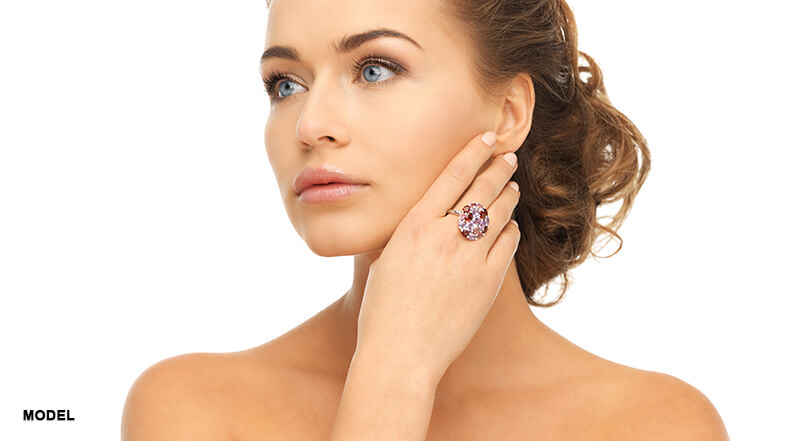Poikiloderma Of Civatte Treatment And Prevention Options

Poikiloderma of Civatte is a harmless, chronic condition in which skin on the chest and neck area demonstrate a specific pattern of redness, hyperpigmentation, and hypopigmentation. Poikiloderma of Civatte can be referred to as sun aging or photodamaged skin, and is also accompanied by thinning of the skin. The skin condition is most common in adults with fair skin and is associated with sun exposure and/or sun sensitivity. Symptoms typically occur in a symmetrical pattern on both sides of the neck. Usually the area under the chin, which is more frequently shadowed, is unaffected.
What are the Clinical Features Poikiloderma of Civatte?
Poikiloderma of Civatte is identified by the following common findings:
- Alternating areas of red and brown pigmentation, and areas of sparing where no color change is seen.
- Many tiny, visible broken blood vessels
- Thin skin in the neck and upper chest area
- Mild burning or itching in red areas (although this symptom is rare)
These findings typically appear in the following pattern:
- Symmetrical on both sides of the neck and/or in the center, upper chest area
- Areas shaded by the chin are often not affected.
Causes of Poikiloderma of Civatte
While the cause of Poikiloderma of Civatte is still unknown, most doctors agree it’s related to long term sun exposure. However, the following conditions are correlated with a greater risk of Poikiloderma of Civatte:
- Genetics – You’re more likely to have Poikiloderma of Civatte if someone in your family had it.
- Age – Sun exposure accumulates with age, leading to greater risk of Poikiloderma of Civatte.
- Hormonal changes – Those with low estrogen due to menopause or surgery are at greater risk.
- Gender – Women are far more likely to have Poikiloderma of Civatte than men.
- Allergies – Some scented skin care products and cosmetics have been associated with Poikiloderma of Civatte due to increasing sun sensitivity.
- Photosensitivity – Skin care products which cause skin to be vulnerable to UV light can increase risk of Poikiloderma of Civatte.
Generally, it’s agreed the primary cause of symptoms is UV light exposure. Patients who already have Poikiloderma of Civatte find their skin condition worsens with continued exposure to sun.
Can Poikiloderma of Civatte be Prevented?
Prevention is the best defense against Poikiloderma of Civatte. Preventative action can also protect against further damage once symptoms begin to appear. Those who have fair skin and those who spend a lot of time in the sun should be especially vigilant about taking preventative measures, since they are most at risk.
- Avoid UV light exposure during peak times, when the UV index 5-6 or greater.
- Use a full spectrum sunscreen that protects against both UVA and UVB rays every day.
- Wear wide brimmed hats and protective clothing to limit sun exposure.
- Remember to address your neck and chest in your skin care routine.
Treatments for Poikiloderma of Civatte
Poikiloderma of Civatte can be very difficult to treat, so preventative measures should be emphasized. Protecting the skin from sun exposure not only prevents symptoms from worsening but may even help symptoms improve. Using a broad-spectrum mineral containing sunscreen (zinc oxide) with SPF 50 or greater will help prevent further damage.
Topical retinoids (such as tretinoin), antioxidants, and alpha hydroxy-acids can be used in conjunction with procedural treatments as adjunctive therapy. These can be beneficial if used long term and can help maintain results from laser. Some skin lightening creams (such as prescription strength hydroquinone combinations) can address hyperpigmentation, but they won’t improve the appearance of burst capillaries.
Currently, laser therapy is the go-to treatment for Poikiloderma of Civatte. The best forms of treatment for Poikiloderma of Civatte are lasers that can address reds and browns and lasers that stimulate collagen regrowth. Some examples are Pulsed Dye Lasers, Intense Pulsed Light (IPL) Therapy and non-ablative fractional laser (such as Fraxel).
Pulsed Dye Lasers (PDL) are strong, focused lasers which operate at a single wavelength. They target blood vessels below the skin without damaging the skin itself. This outpatient treatment helps reduce redness. PDLs may induce temporary bruising or swelling, making redness appear worse before it gets better. Multiple sessions are required for best results.
Intense Pulsed Light (IPL) therapy also improves discoloration. Intense Pulsed Light lasers work at several different wavelengths to target both blood vessels and melanin. They also stimulate collagen production which may improve skin thickness. IPL is not as strong as PDL which means more treatment sessions are typically needed to achieve results.
Fractional Laser targets both the epidermis and dermis and leads to collagen remodeling and new collagen growth. It is important to note that the results are gradual and not immediate. Multiple sessions are required and maximum results may take up to 6 months to achieve.
If you’re beginning to see the symptoms of Poikiloderma of Civatte, protect yourself from the sun to avoid further damage and consult with your dermatologist.
Disclaimer: The contents of the Westlake Dermatology website, including text, graphics, and images, are for informational purposes only and are not intended to substitute for direct medical advice from your physician or other qualified professional.

I was recently diagnosed with POC. I have irritating chronic pain in the affected area, left neck/shoulder. Any suggestions?
Hi Denny,
I’m sorry to hear about your diagnosis. Your best bet would be to see a dermatologist as soon as possible for ways to manage the condition. If you are in Texas, please feel free to give us a call to schedule an appointment.
Thanks,
WD Staff
I recently had 3 treatments of the genesis laser and it didn’t do anything for the redness.
I had it Westlake dermatology Lakeway. What other laser would you suggest to try next?
Mine is bad and it also gets extremely itchy at times.
Thanks!
Hi Sharon,
We’re sorry to hear about the issue, please feel free to contact us for a resolution. You may need a more intensive laser or alternative treatment. Please give us a call at (512) 610-0549 to discuss further.
Thanks,
WD Staff